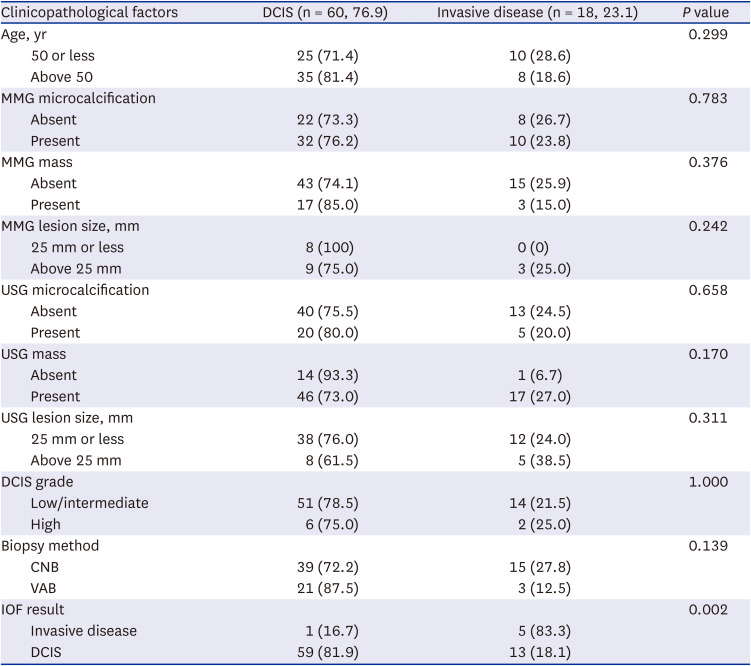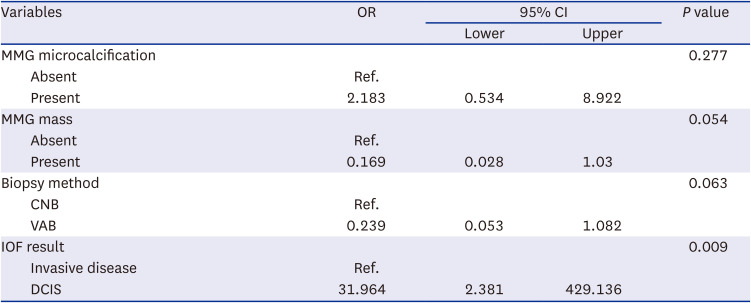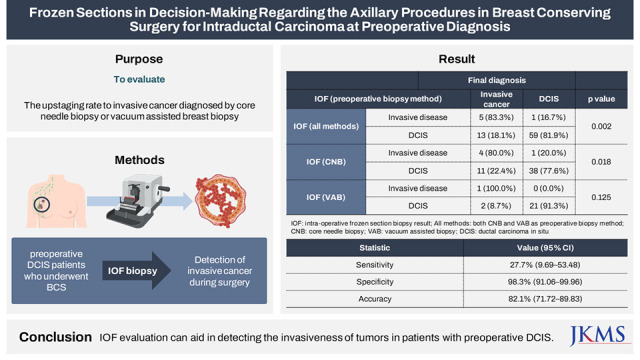1. Ernster VL, Ballard-Barbash R, Barlow WE, Zheng Y, Weaver DL, Cutter G, et al. Detection of ductal carcinoma in situ in women undergoing screening mammography. J Natl Cancer Inst. 2002; 94(20):1546–1554. PMID:
12381707.
2. Narod SA, Iqbal J, Giannakeas V, Sopik V, Sun P. Breast cancer mortality after a diagnosis of ductal carcinoma in situ. JAMA Oncol. 2015; 1(7):888–896. PMID:
26291673.
3. Intra M, Rotmensz N, Veronesi P, Colleoni M, Iodice S, Paganelli G, et al. Sentinel node biopsy is not a standard procedure in ductal carcinoma in situ of the breast: the experience of the European institute of oncology on 854 patients in 10 years. Ann Surg. 2008; 247(2):315–319. PMID:
18216539.
4. Park HS, Park S, Cho J, Park JM, Kim SI, Park BW. Risk predictors of underestimation and the need for sentinel node biopsy in patients diagnosed with ductal carcinoma in situ by preoperative needle biopsy. J Surg Oncol. 2013; 107(4):388–392. PMID:
23007901.
5. Zetterlund L, Stemme S, Arnrup H, de Boniface J. Incidence of and risk factors for sentinel lymph node metastasis in patients with a postoperative diagnosis of ductal carcinoma in situ. Br J Surg. 2014; 101(5):488–494. PMID:
24493058.
6. van Roozendaal LM, Goorts B, Klinkert M, Keymeulen KB, De Vries B, Strobbe LJ, et al. Sentinel lymph node biopsy can be omitted in DCIS patients treated with breast conserving therapy. Breast Cancer Res Treat. 2016; 156(3):517–525. PMID:
27083179.
7. Giordano SH, Elias AD, Gradishar WJ. NCCN Guidelines updates: breast cancer. J Natl Compr Canc Netw. 2018; 16(5S):605–610. PMID:
29784737.
8. Kim S, Kim J, Park HS, Kim HY, Lee K, Lee J, et al. An updated nomogram for predicting invasiveness in preoperative ductal carcinoma in situ of the breast. Yonsei Med J. 2019; 60(11):1028–1035. PMID:
31637884.
9. Brennan ME, Turner RM, Ciatto S, Marinovich ML, French JR, Macaskill P, et al. Ductal carcinoma in situ at core-needle biopsy: meta-analysis of underestimation and predictors of invasive breast cancer. Radiology. 2011; 260(1):119–128. PMID:
21493791.
10. Tan EY, Lo ZW, Ang CH, Teo C, Seah MD, Chen JJ, et al. Sentinel lymph node biopsy should be included with the initial surgery for high-risk ductal carcinoma-in-situ. Int Sch Res Notices. 2014; 2014:624185. PMID:
27379334.
11. Prendeville S, Ryan C, Feeley L, O’Connell F, Browne TJ, O’Sullivan MJ, et al. Sentinel lymph node biopsy is not warranted following a core needle biopsy diagnosis of ductal carcinoma in situ (DCIS) of the breast. Breast. 2015; 24(3):197–200. PMID:
25681861.
12. Jakub JW, Murphy BL, Gonzalez AB, Conners AL, Henrichsen TL, Maimone S 4th, et al. A validated nomogram to predict upstaging of ductal carcinoma in situ to invasive disease. Ann Surg Oncol. 2017; 24(10):2915–2924. PMID:
28766196.
13. Park HS, Kim HY, Park S, Kim EK, Kim SI, Park BW. A nomogram for predicting underestimation of invasiveness in ductal carcinoma in situ diagnosed by preoperative needle biopsy. Breast. 2013; 22(5):869–873. PMID:
23601760.
14. Kurniawan ED, Rose A, Mou A, Buchanan M, Collins JP, Wong MH, et al. Risk factors for invasive breast cancer when core needle biopsy shows ductal carcinoma in situ. Arch Surg. 2010; 145(11):1098–1104. PMID:
21079099.
15. Murphy BL, Gonzalez AB, Keeney MG, Chen B, Conners AL, Henrichsen TL, et al. Ability of intraoperative pathologic analysis of ductal carcinoma in situ to guide selective use of sentinel lymph node surgery. Am Surg. 2018; 84(4):537–542. PMID:
29712602.
16. Knuttel FM, Menezes GL, van Diest PJ, Witkamp AJ, van den Bosch MA, Verkooijen HM. Meta-analysis of the concordance of histological grade of breast cancer between core needle biopsy and surgical excision specimen. Br J Surg. 2016; 103(6):644–655. PMID:
26990850.
17. Mitchell KB, Lin H, Shen Y, Colfry A, Kuerer H, Shaitelman SF, et al. DCIS and axillary nodal evaluation: compliance with national guidelines. BMC Surg. 2017; 17(1):12. PMID:
28173790.
18. Thanasitthichai S, Chaiwerawattana A, Phadhana-Anake O. Impact of using intra-operative ultrasound guided breast- conserving surgery on positive margin and re-excision rates in breast cancer cases with current SSO/ASTRO Guidelines. Asian Pac J Cancer Prev. 2016; 17(9):4463–4467. PMID:
27797262.
19. Anila KR, Chandramohan K, Mathews A, Somanathan T, Jayasree K. Role of frozen section in the intra-operative margin assessment during breast conserving surgery. Indian J Cancer. 2016; 53(2):235–238. PMID:
28071617.
20. Suh YJ, Kim MJ, Kim EK, Moon HJ, Kwak JY, Koo HR, et al. Comparison of the underestimation rate in cases with ductal carcinoma in situ at ultrasound-guided core biopsy: 14-gauge automated core-needle biopsy vs 8- or 11-gauge vacuum-assisted biopsy. Br J Radiol. 2012; 85(1016):e349–e356. PMID:
22422382.
21. Gentilini O, Veronesi U. Abandoning sentinel lymph node biopsy in early breast cancer? A new trial in progress at the European Institute of Oncology of Milan (SOUND: Sentinel node vs Observation after axillary UltraSouND). Breast. 2012; 21(5):678–681. PMID:
22835916.
22. Jatoi I, Benson JR, Toi M. De-escalation of axillary surgery in early breast cancer. Lancet Oncol. 2016; 17(10):e430–e441. PMID:
27733269.
23. Hwang ES, Hyslop T, Lynch T, Frank E, Pinto D, Basila D, et al. The COMET (Comparison of Operative versus Monitoring and Endocrine Therapy) trial: a phase III randomised controlled clinical trial for low-risk ductal carcinoma in situ (DCIS). BMJ Open. 2019; 9(3):e026797.
24. Pilewskie M, Olcese C, Patil S, Van Zee KJ. Women with low-risk DCIS eligible for the LORIS trial after complete surgical excision: how low is their risk after standard therapy? Ann Surg Oncol. 2016; 23(13):4253–4261. PMID:
27766556.








 PDF
PDF Citation
Citation Print
Print




 XML Download
XML Download